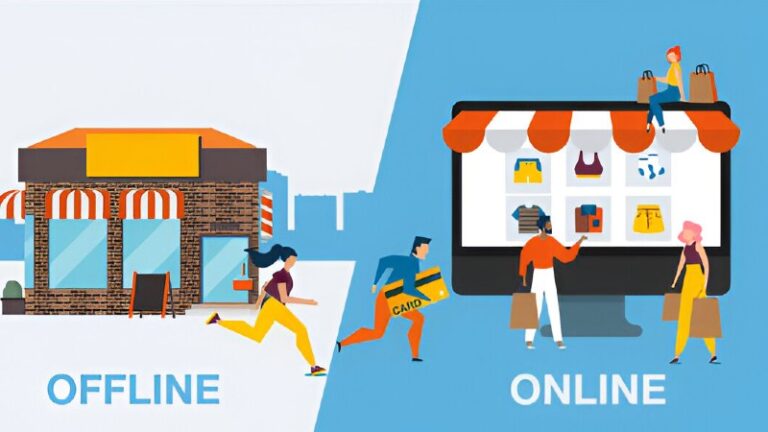The retail world is in constant flux. While e-commerce has seen an extraordinary surge, projected to reach a staggering $58.74 trillion globally by 2028, physical stores are far from obsolete. In 2024, 16% of total retail sales were e-commerce, with the vast majority still occurring in physical locations. This isn’t a battle of attrition; it’s a dynamic interplay where both channels offer distinct value propositions. Understanding these differences is the first step to becoming a more effective shopper.
What is Online Shopping?
Online shopping, or e-commerce, involves purchasing goods and services via the internet using devices like smartphones or computers. It’s a virtual marketplace where you can browse extensive catalogs, add items to a digital cart, and complete transactions with just a few clicks, all from the comfort of your chosen location. This method thrives on accessibility, speed, and a seemingly endless selection.
What is In-Store Shopping?
In-store shopping, often referred to as traditional or brick-and-mortar shopping, entails physically visiting a retail establishment to buy products or services. This age-old method offers immediate gratification, the tangible experience of interacting with products, and direct human interaction with sales staff. It’s a multi-sensory experience that extends beyond mere transaction.
The Distinct Advantages of Online Shopping
The digital realm has reshaped our buying habits by offering unparalleled convenience and choice. Here’s a closer look at the key benefits:
- Unmatched Convenience and Accessibility: Imagine shopping for groceries at 2 AM or buying a gift during a work break. Online stores are open 24/7, transcending geographical and time limitations. This flexibility is a game-changer for busy individuals, those with mobility challenges, or anyone living in remote areas.
- Vast Product Selection: Physical stores are limited by shelf space and inventory. Online platforms, however, offer a virtually unlimited array of products from local artisans to international brands, including niche and off-season items. This unparalleled variety significantly increases your chances of finding exactly what you need.
- Effortless Price Comparison: Gone are the days of driving to multiple stores to compare prices. With online shopping, a few clicks or the use of comparison tools instantly reveals the best deals across various retailers. This fosters a highly competitive environment, often leading to lower prices for consumers.
- Empowering Research and Reviews: Before making a purchase, especially a significant one, online shoppers can delve into a wealth of information. Product descriptions, specifications, expert reviews, and, crucially, unfiltered customer feedback provide valuable insights into quality, sizing, and overall satisfaction, fostering buyer confidence.
- Time-Saving Efficiency: Online shopping streamlines the entire process. No commuting, no searching for parking, no navigating crowded aisles, and no long checkout lines. A quick search and a few clicks can complete a shopping list that might otherwise take hours in a physical setting.
- Freedom from Sales Pressure: For those who find assertive sales associates uncomfortable, online shopping offers a pressure-free environment. You can take your time, browse at your leisure, and make decisions without feeling rushed or obligated.
- Global Reach for Businesses: For entrepreneurs, an online store translates into worldwide sales opportunities. The customer base expands beyond local demographics, allowing businesses to tap into international markets and attract new customers from virtually anywhere.
- Lower Overhead Costs: Operating an online store generally involves significantly lower expenses compared to a brick-and-mortar establishment. Reduced costs for rent, utilities, and extensive staffing can lead to higher profit margins or enable more competitive pricing.
- Business Automation and Data Insights: E-commerce platforms facilitate automation of processes like inventory management and order fulfillment. Crucially, they provide rich customer data, enabling businesses to segment customers, personalize marketing efforts, and understand purchasing behavior with unprecedented detail.
The Enduring Appeal of In-Store Shopping
Despite the digital revolution, traditional shopping continues to thrive, appealing to fundamental human desires for sensory engagement and social connection. Here’s why it maintains its strong foothold:
- Tangible Product Inspection and Trial: There’s simply no substitute for physically interacting with a product. In a store, you can feel the texture of a fabric, test the comfort of furniture, gauge the true color of an item, or try on clothes for a perfect fit. This immediate, sensory engagement is invaluable for many purchasing decisions.
- Instant Gratification: Walk in, buy, and walk out. The instant gratification of taking your purchased item home immediately, without waiting days or weeks for delivery, is a significant draw, especially for urgent needs or last-minute gifts.
- Personalized Customer Service and Expert Advice: In-store, you can directly interact with knowledgeable sales associates. They can offer real-time answers to questions, provide personalized recommendations, and offer expert guidance that chatbots or online FAQs simply cannot replicate, especially for complex or high-value items.
- The Social Experience: Shopping can be a social activity. Visiting stores with friends or family offers an opportunity for shared experiences, instant feedback, and bonding, transforming a chore into an enjoyable outing.
- Sensory Atmosphere and Discovery: Physical stores cultivate a unique ambiance through design, lighting, music, and even scent marketing. This tangible atmosphere can make shopping a pleasurable, even therapeutic, experience. It also allows for serendipitous discoveries – stumbling upon an item you didn’t even know you wanted.
- No Shipping Costs or Delays: You avoid all shipping fees and the frustration of delivery delays, lost packages, or damaged goods. What you buy is immediately yours, in hand, ensuring its condition.
- Simpler Returns and Exchanges: Generally, returning or exchanging an item bought in-store is more straightforward. You can often bring the item back to the store for an immediate refund or exchange, avoiding the hassle of repacking and shipping.
- Support for Local Businesses: For many consumers, choosing to shop at a brick-and-mortar store is a conscious decision to support local economies, foster community ties, and contribute to job creation within their area.
- Reduced Online Security Concerns: For those wary of sharing personal and financial information online, in-store shopping offers a perceived higher level of security, as transactions happen in person.
Disadvantages of Both Shopping Methods
No shopping method is perfect. Both online and in-store experiences come with their own set of drawbacks:
| Disadvantages of Online Shopping | Disadvantages of In-Store Shopping |
| Lack of Physical Inspection: Inability to touch, feel, or try on products before purchase. | Limited Selection: Restricted by physical space and store inventory, often missing specific sizes, colors, or brands. |
| Shipping Costs and Delays: Additional fees and waiting periods for delivery; risk of lost or damaged items. | Time-Consuming: Requires travel, finding parking, navigating crowds, and waiting in checkout lines. |
| Returns Process Complexity: Can be cumbersome, involving repackaging, shipping, and waiting for refunds/exchanges. | Higher Prices: Due to operational overheads like rent, utilities, and staff wages, prices can sometimes be higher. |
| Security Concerns: Vulnerability to fraud, hacking, and data breaches when sharing personal/financial information online. | Inconvenience/Limited Hours: Stores have fixed operating hours, which may not suit busy schedules; location may be inconvenient. |
| Lack of Personal Interaction: Minimal human interaction, relying on chatbots or email support. | Crowds and Queues: Can be stressful and time-consuming, especially during peak shopping seasons. |
| Potential for Impulse Buying (Digital): Persuasive ads, recommendation algorithms, and one-click purchasing can lead to unplanned spending. | Sales Pressure: Sales associates, especially those on commission, can create an uncomfortable environment for some shoppers. |
| Product Misrepresentation: Images can be edited, leading to disappointment when the physical product doesn’t match expectations. | Geographical Limitations for Businesses: Restricts customer reach to a localized area, hindering broader market expansion. |
A Strategic Approach
The optimal shopping method often depends on the specific product, your priorities, and the situation. Here’s a guide to help you decide:
Choose Online Shopping When:
- Convenience is paramount: You have a busy schedule, prefer shopping from home, or need to shop outside traditional hours.
- You need a vast selection: Looking for a niche item, specific brand, or comparing many options (e.g., electronics, books, rare collectibles).
- Price comparison is key: Hunting for the best deal and willing to wait for delivery.
- You’re comfortable with digital research: Relying on reviews, specifications, and product descriptions (e.g., appliances, software).
- The item doesn’t require physical inspection: Consumables, digital products, or items you’ve bought before.
- You want to avoid crowds: During peak holiday seasons or for a stress-free experience.
Choose In-Store Shopping When:
- Physical inspection is crucial: For items where touch, fit, or feel is important (e.g., clothing, shoes, furniture, fresh produce).
- You need immediate gratification: You need the item right away (e.g., last-minute gifts, urgent repairs).
- Personalized advice is desired: Seeking expert recommendations or assistance for complex purchases (e.g., luxury goods, tailored clothing, electronics advice).
- You prefer a social experience: Shopping with friends or family, or enjoying the store’s ambiance.
- You want to support local businesses: Contributing to your community.
- You’re wary of online security concerns: Preferring in-person transactions.
- Returns might be likely: Easier to manage a physical return.
The Rise of the Omnichannel Shopper
The most insightful trend isn’t choosing one over the other, but rather seamlessly blending both. The future of retail lies in the omnichannel experience, where consumers leverage the strengths of online and in-store shopping in an integrated fashion. This is the fresh perspective that truly redefines modern retail.
Consider these scenarios:
- Research Online, Purchase In-Store (ROPO): You spend hours comparing laptop specifications and reading reviews online, then visit a physical store to see the model, test the keyboard, and get immediate gratification.
- Buy Online, Pick Up In-Store (BOPIS) / Click-and-Collect: You enjoy the convenience of online Browse and payment, then pick up your order at the store, avoiding shipping fees and delays, often benefiting from the store’s immediate stock availability. This model has seen a significant surge, particularly since the pandemic.
- In-Store Browse, Online Purchase: You try on clothes in a boutique to confirm fit and style, then buy them online later if you find a better deal or wait for a sale.
- Virtual Try-On in Physical Stores: Using AR/VR technology in a physical store to visualize how an item looks on you without physically trying it on, blurring the lines between digital and physical interaction.
This blending of experiences is driven by technology. Augmented Reality (AR) and Virtual Reality (VR) are enhancing both online (virtual try-ons) and offline (interactive displays) shopping. AI and data analytics are powering personalized recommendations across channels. Mobile commerce has made seamless transactions possible both online and via in-store mobile payments. Social commerce influences both, as online discoveries drive offline visits. Even sustainability concerns are shaping logistics and in-store practices simultaneously.
Conclusion
The debate over online vs. in-store shopping: pros and cons of each and when to choose which is no longer about one method dominating the other. It’s about recognizing the unique value proposition of each and, more importantly, understanding how they complement each other. The ultimate power lies with the consumer, who can strategically choose the most advantageous channel based on their specific needs, or seamlessly combine both for a truly optimized shopping journey. By understanding the distinct benefits and drawbacks, and embracing the evolving omnichannel landscape, you can master your shopping experience, making every purchase a thoughtful and efficient decision.
Frequently Asked Questions (FAQs)
What is the main difference between online and in-store shopping?
Online shopping offers convenience and vast selection from anywhere, while in-store shopping provides immediate gratification and physical interaction with products.
Which shopping method is generally more convenient?
Online shopping is typically more convenient as it’s available 24/7 from home, eliminating travel and store hours.
Are prices usually lower online or in physical stores?
Online stores often have lower prices due to reduced overhead costs, making price comparison easier for consumers.
When is in-store shopping a better choice?
In-store shopping is ideal when you need to physically inspect, try on, or immediately take home a product, or if you prefer personalized assistance.
What is an omnichannel shopping experience?
Omnichannel shopping blends online and in-store methods, allowing consumers to seamlessly use both channels for a single purchase journey, like researching online and buying in-store.
How does technology impact both online and in-store shopping?
Technology enhances both, with e-commerce platforms and mobile apps for online, and features like AR/VR, mobile payments, and AI-driven personalization improving the in-store experience.


